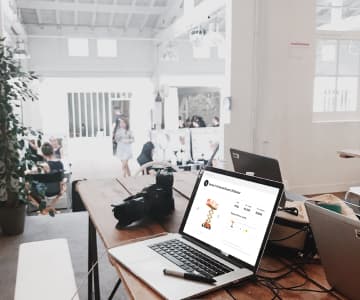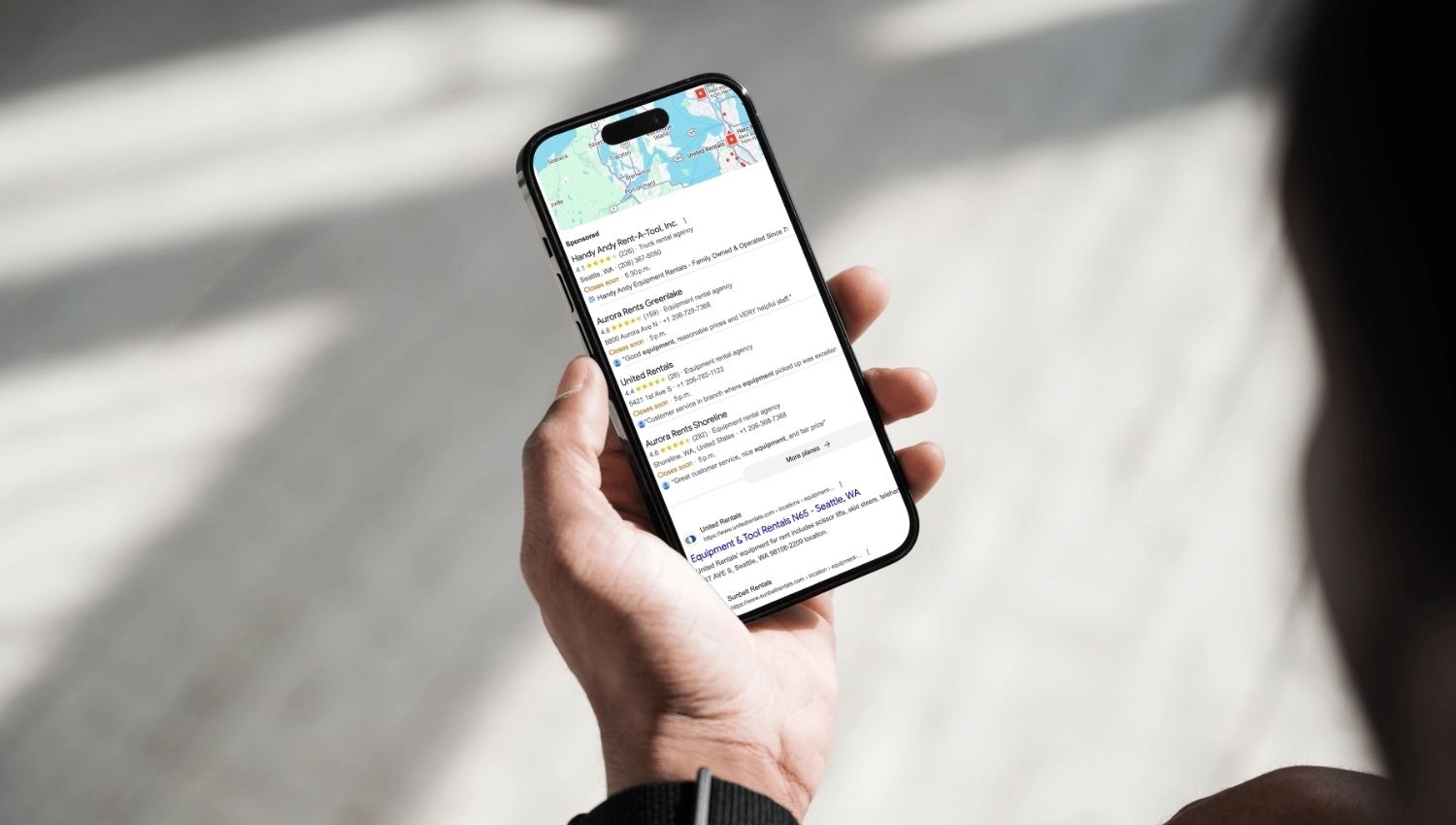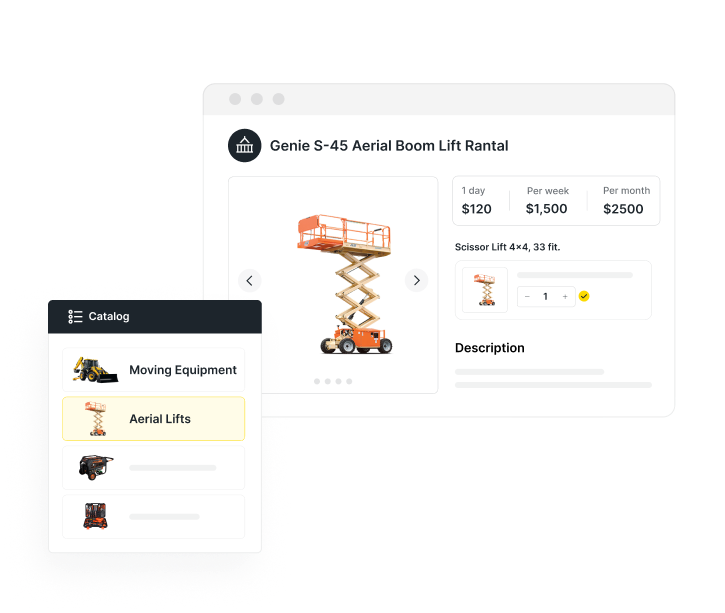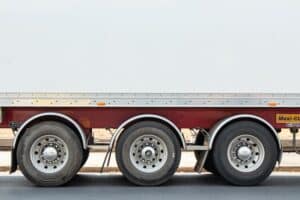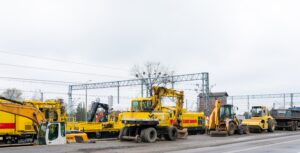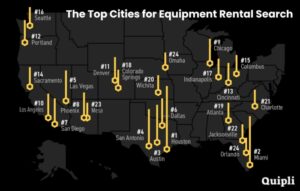You know your equipment rental business deserves more customers, maybe you’re unsure about how to reach them? You’re not alone—many rental operators struggle to break through the noise and connect with the right audience.
By the end of this article, you’ll have nine proven marketing strategies that successful equipment rental companies use to drive more rentals, build brand awareness, and break free from “rental gridlock“—the operational and visibility challenges that hold rental businesses back.
1. Build a Beautiful Rental Website
Your website is often the first interaction potential customers have with your equipment rental business. In today’s digital-first world, your equipment rental website needs to deliver an exceptional experience that converts visitors into customers.
Modern equipment rental customers expect specific capabilities from your website:
- Browse inventory with detailed specifications
- Check real-time availability instantly
- Complete reservations online 24/7
- Upload insurance documentation
- Sign rental agreements digitally
- Choose between delivery and pickup options
Making Your Website Work Harder
A professional rental website needs both form and function. High-quality equipment photos should load quickly. Filtering options must help customers find specific models fast. The checkout process should feel familiar, like any major e-commerce site.
Industry experts from the Rental Roundtable podcast emphasize that rental websites must answer three questions immediately: “Do you have what I need? Is it available when I need it? How much will it cost?” Sites that bury this information see 70% higher bounce rates.
Budget between $5,000-$15,000 for a custom rental website, or $300-$500 monthly for platforms with integrated booking capabilities. The investment typically pays for itself within 6-12 months through increased conversions and reduced phone time.
Pro Tip: Quipli’s rental website builder creates mobile-optimized storefronts with real-time availability checks and integrated damage waiver options. You can offer the same sophisticated online experience as national chains without enterprise-level complexity.
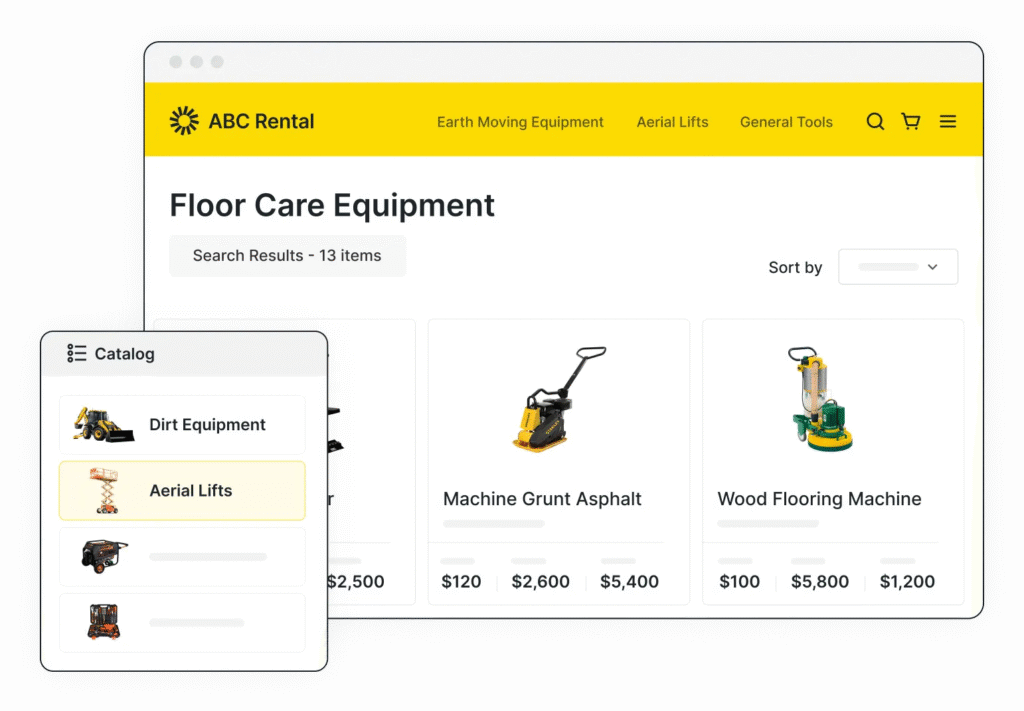

Quipli Website Builder Feature
2. Clearly Define Your Target Audience
Before launching any marketing campaign, you need crystal-clear understanding of who you’re trying to reach. Equipment rental businesses often serve diverse markets, and each segment requires different messaging.
Start by analyzing your current customer base:
- Industry representation (construction, events, residential)
- Company size and project scope
- Typical rental duration
- Average order value
- Geographic concentration
Creating Actionable Buyer Personas
Let’s look at two distinct personas for a typical equipment rental business:
Commercial Carl – General contractor managing 3-5 projects simultaneously. Rents heavy and construction equipment for 2-4 week periods. Values reliability over price. Needs flexible terms and quick equipment swaps. Responds best to LinkedIn outreach and industry publications.
DIY Diana – Homeowner tackling weekend projects. Rents 1-2 times yearly. Prioritizes ease of use and clear instructions. Needs delivery options and damage waivers. Finds rental companies through Google searches and Facebook recommendations.
These personas guide everything from website copy to social media strategy. Commercial Carl needs bulk discount information and commercial credit applications. DIY Diana wants tutorial videos and weekend special promotions.
Geographic targeting matters too. Map your actual delivery radius and identify construction hotspots. If you’re seeing permits spike in certain zip codes, that’s where your marketing dollars should flow.
3. Master PPC & Google Ads
Pay-per-click advertising delivers immediate visibility for equipment rental businesses. Unlike SEO, which takes months to show results, a well-crafted Google Ads campaign drives qualified leads within hours.
Setting Up Your First Campaign
Start with a modest budget of $1,500-$3,000 monthly. Focus on high-intent keywords that indicate immediate rental need:
- “excavator rental near me”
- “same day equipment delivery [city]”
- “weekend tool rental [zip code]”
Set up separate campaigns for different equipment categories. This maintains relevance and controls budgets effectively. A concrete equipment campaign might get $500 monthly, while aerial lifts get $750 based on margin and demand.
Location targeting becomes crucial for rental businesses. Use these proven strategies:
- Bid 25% higher for searches within 5 miles of your yard
- Decrease bids by 15% for 20+ mile radius searches
- Exclude areas outside your delivery zone entirely
- Add bid adjustments for commercial zip codes (+20%)
Maximizing Your Ad Spend
Track these key metrics, weekly:
- Cost per lead (target: $25-$50)
- Conversion rate (target: 3-5%)
- Average order value from ads ($500+)
- Return on ad spend (target: 4:1 minimum)
Remarketing campaigns recapture lost opportunities. Someone who viewed your skid steer page but didn’t convert might need a 10% discount reminder. Budget 20% of your PPC spend for remarketing—it typically delivers 50% higher conversion rates.
4. Create a Content Strategy and Publish Content Regularly
Content marketing builds your rental company’s online authority while attracting customers through valuable information. The key is answering questions your customers actually ask.
Another key part of your content strategy is your equipment rental SEO strategy. Showing up on the top page for major keywords that you’re bidding on in your Google Ads strategy will help you have a long-term and effective inbound marketing channel.
Building Your Content Calendar
Map content to your rental seasons and customer needs:
Winter Content (December-February):
- “Heating Equipment Sizing Guide for Construction Sites”
- “Winter Concrete Pour Equipment Checklist”
- “Generator Maintenance in Cold Weather”
Spring Content (March-May):
- “Landscape Equipment Rental vs. Purchase Calculator”
- “Choosing the Right Tiller for Your Soil Type”
- “Permit Requirements for Excavation Projects”
Aim for one substantial piece weekly (800-1,200 words). This consistency matters more than volume. Create an editorial calendar three months ahead, leaving room for timely topics.
Content Types That Drive Rentals
Different content formats serve different purposes:
Equipment Guides (highest conversion): Detailed breakdowns of specific equipment with project applications. “Mini Excavator Model Comparison: 3,000 vs 5,000 lb Machines” directly influences rental decisions.
Project Tutorials (best for SEO): Step-by-step guides using rental equipment. “How to Grade a Driveway with a Skid Steer” ranks well and demonstrates expertise.
Safety Content (builds trust): OSHA compliance guides and equipment operation tips. Shows professionalism while providing genuine value.
Cost Calculators (lead generation): Interactive tools comparing rental vs purchase costs. Captures contact information while providing personalized insights.
Budget 10-15 hours monthly for content creation, or outsource for $500-$1,500 per month. The compound effect means content published today continues driving traffic years later.
Winning with Video Content
5. Make Sure Your Site Includes High-Quality Photos
Visual content can make or break an equipment rental sale. When customers can’t physically inspect equipment, photographs become their primary evaluation tool.
Photo Requirements for Maximum Impact
Every piece of equipment needs these six shots:
- Hero angle (3/4 view showing overall condition)
- Control panel close-up
- Model/serial number plate
- Included attachments or accessories
- Equipment in use (action shot)
- Damage or wear areas (builds trust through transparency)
Professional photography costs $150-$300 per hour. Most rental companies can photograph their core fleet (20-30 units) in a full day. This $1,500-$2,500 investment serves multiple purposes across all marketing channels.
Creating Consistency Across Your Fleet
Establish photo standards that create a cohesive brand experience:
Use the same outdoor location with consistent lighting (overcast days work best). Position equipment at the same angle with a clean background. Include a person for scale on larger equipment.
These standards matter because consistency builds professionalism. When every excavator photo looks similar, customers can easily compare models. Random photos from different angles and lighting look amateur.
Consider seasonal photo updates for high-demand equipment. That zero-turn mower photographed in dead grass won’t inspire spring rentals. Fresh photos showing equipment in seasonal context improve conversion rates 15-20%.
6. Get Active on Social Media
Social media transforms equipment rental marketing from broadcast to conversation. But success requires platform-specific strategies, not generic posting.
Platform Selection and Strategy
Facebook (essential for all rental businesses):
- Post frequency: 3-4 times weekly
- Best content: Equipment highlights, safety tips, customer projects
- Advertising strength: Detailed local targeting
- Expected engagement rate: 1-3%
Instagram (visual equipment showcase):
- Post frequency: 2-3 times weekly
- Best content: Equipment in action, before/after projects, time-lapses
- Use 10-15 relevant hashtags per post
- Stories feature for daily equipment spotlights
LinkedIn (B2B focus):
- Post frequency: 1-2 times weekly
- Best content: Industry insights, fleet additions, safety achievements
- Personal profiles amplify company page reach
- Direct messaging for contractor outreach
Content That Actually Engages
Stop posting equipment catalog photos with “Now available!” captions. Instead, create content that provides value:
Monday Motivation: Feature a customer project with permission. “ABC Contractors used our 325 excavator to complete Phase 1 of the Riverside development ahead of schedule.”
Wednesday Wisdom: Share equipment tips. “Did you know? Running your generator at 50% capacity extends its life by 30%. Here’s why…”
Friday Feature: Highlight team members or new equipment additions. People connect with people, not brands.
Budget 5-10 hours weekly for social media management, or hire a freelancer for $500-$1,500 monthly. Track metrics that matter: reach, engagement, and most importantly, leads generated.
Pro Tip: Use Quipli’s real-time availability data for urgency posts. “Only 2 skid steers available this weekend!” creates authentic FOMO while providing customer value.
Recommended Reading: What We Can Learn From Sunbelt Rentals’ Marketing Strategy
7. Create an Email Marketing Strategy
Email marketing delivers the highest ROI of any digital channel—$42 for every $1 spent on average. For equipment rental businesses, email nurtures relationships while driving repeat rentals.
Building Your Email Program
Start with four essential email sequences:
Welcome Series (3 emails over 10 days):
- Email 1: Welcome and rental process overview
- Email 2: Popular equipment spotlight with availability
- Email 3: First-time renter discount (15-20% off)
Abandoned Cart Recovery (2 emails):
- Email 1 (2 hours later): “Complete your reservation”
- Email 2 (24 hours later): “Need help with your rental?”
Post-Rental Follow-up (2 emails):
- Email 1 (Next day): Thank you and feedback request
- Email 2 (30 days): Related equipment suggestions
Seasonal Campaigns (Monthly):
- Equipment recommendations for upcoming season
- Maintenance reminders for regular renters
- Special promotions for slow periods
Segmentation Strategies That Work
Generic emails to your entire list waste opportunity. Segment based on rental behavior:
High-Value Contractors (20% of list, 60% of revenue): Weekly equipment availability updates. Project planning resources. Volume discount reminders. Priority booking notifications.
Occasional DIY Renters (60% of list, 25% of revenue): Monthly project inspiration. Seasonal equipment guides. Weekend special promotions. How-to content.
Dormant Customers (20% of list, 15% of revenue potential): Win-back campaigns with discounts. New equipment announcements. “We miss you” personal outreach.
Email platforms cost $50-$300 monthly depending on list size. Expected metrics: 25-35% open rate, 3-5% click rate, 1-2% conversion rate.
8. Follow Up with Past Customers
Returning customers are known to spend more than compared to cold prospects. Strategic follow-up transforms one-time renters into loyal customers.
The Follow-Up Timeline
Create a systematic approach based on customer type:
Commercial Accounts:
- 24 hours post-rental: Thank you and feedback request
- 2 weeks: Check project progress, suggest complementary equipment
- Monthly: Share availability updates and industry insights
- Quarterly: Account review and needs assessment
Residential Customers:
- 24 hours post-rental: Thank you and review request
- 30 days: Related project suggestions
- Seasonally: Relevant equipment reminders
- Annually: Birthday or anniversary discount
Implementing Referral Programs
A referral program is also a great way to incentivize your customers or relevant referral partners. Turn satisfied customers into active promoters with structured incentives:
Referral Reward Structure:
- $50 account credit for each new customer referred
- 10% discount for referred customer’s first rental
- Double rewards during slow seasons
- VIP status after 5 successful referrals
Make referrals easy to track. Provide unique referral codes, branded referral cards, or simple online forms. Follow up within 24 hours to thank referrers and confirm rewards.
Pro Tip: Quipli’s customer portal gives renters 24/7 access to rental history and upcoming reservations. This self-service capability keeps your brand accessible while reducing phone calls.


9. Invest in Quality Rental Management Software
Modern rental management software isn’t just back-office efficiency—it’s a marketing enabler that directly impacts customer experience and growth capability.
How Software Amplifies Marketing
The right platform eliminates operational gridlock that frustrates customers:
Real-time Availability prevents double-bookings and disappointed customers. Nothing damages reputation faster than confirming equipment that isn’t actually available.
Automated Communications ensure consistent follow-up. Welcome emails, rental reminders, and feedback requests happen automatically.
Digital Convenience meets modern expectations. Online booking, digital contracts, and text-to-rent features capture customers who won’t call.
Reporting Intelligence reveals opportunities. See which equipment has low utilization for promotion. Identify valuable customer segments for targeted campaigns.


Calculating Software ROI
Quality rental management software costs $200-$1,000 monthly depending on fleet size and features. Here’s typical ROI breakdown:
- Time Savings (20 hours weekly @ $25/hour): $2,000 monthly value Reduced Double-bookings (2 prevented monthly @ $500 each): $1,000 monthly value Increased Online Bookings (15% lift on $50,000 revenue): $7,500 monthly value Better Collections (DSO reduced by 5 days): Improved cash flow
Total value often exceeds $10,000 monthly for mid-sized rental operations. The software pays for itself through efficiency gains alone, with marketing benefits as bonus.
Heavy Construction Equipment Specific Tips
The heavy equipment industry is different. Marketing heavy construction equipment requires specialized strategies accounting for longer rental periods, higher values, and complex customer needs.
Showcase Your Service Capabilities
For heavy equipment rentals, service capabilities are major differentiators. Construction companies need confidence that rented equipment won’t cause project delays.
Service Marketing Elements:
- Response time guarantees (2-hour emergency response)
- Preventive maintenance schedules posted publicly
- Technician certifications and factory training
- Parts inventory depth ($500,000+ in stock)
- Mobile service fleet capabilities
Create service-focused case studies with specific metrics. “How We Achieved 99.5% Uptime for Metro Highway Project” resonates more than generic claims.
Example
A regional rental company partnered with three specialized rental companies to offer “Complete Project Solutions.” They now bid on $10M+ projects previously out of reach, winning 30% and generating $3M in additional revenue.
Build Strategic Fleet Partnerships
Large construction projects require equipment beyond any single company’s inventory. Strategic partnerships expand your capabilities while sharing marketing costs.
Partnership Structure Examples:
- Reciprocal referral agreements (10% commission)
- Bundled project packages (15% discount for complete solutions)
- Cross-rental agreements at preferred rates
- Joint trade show participation ($5,000 shared booth)
- Co-created content and resources
Mountain West Rentals partnered with three specialized rental companies to offer “Complete Project Solutions.” They now bid on $10M+ projects previously out of reach, winning 30% and generating $3M in additional revenue.
Leverage Project-Based Marketing
Construction equipment marketing should align with project lifecycles, not individual transactions.
Project Package Examples:
Site Prep Package ($15,000/month):
- 320 Excavator
- D6 Dozer
- Smooth drum compactor
- Water truck
- Coordinated delivery and pickup
Foundation Package ($8,000/month):
- Mini excavator
- Trencher
- Plate compactor
- Concrete equipment
- Safety barriers
Create project planning resources showcasing your expertise. “Commercial Site Development Equipment Guide” or “Pipeline Project Calculator” provide value while naturally featuring your fleet.
Track project-based metrics differently. Success isn’t daily utilization but project completion rates, total project revenue, and follow-on project capture rates.
Recommended Resource: The Equipment Rental Cost Calculator & Pricing Guide
How Rental Companies Can Win with Digital Marketing | Rental Roundtable
Bringing It All Together
Remember, successful equipment rental marketing isn’t about using every tactic. It’s about choosing the right mix and executing consistently.
Companies that embrace modern marketing while maintaining operational excellence will capture market share from those stuck in outdated approaches.
Ready to transform your rental operation? Quipli’s all-in-one equipment rental management software eliminates rental gridlock while enabling modern customer experiences that drive growth. From rental websites to automated follow-up, we help independent rental companies compete with confidence.
